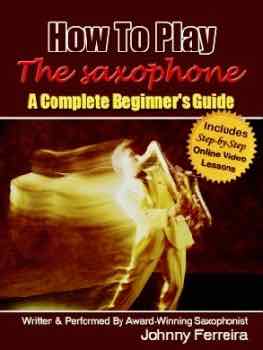Learn the Fingering for the Complete C Major Scale In This Video:
Complete Saxophone Fingering Chart Below
 Want more FREE fingering lessons?
Want more FREE fingering lessons?
Register now and get the first 8 most important beginners lessons for saxophone :
- putting the sax together and proper handling
- how to set up your reed, mouthpiece and ligature
- proper embouchure development
- proper breathing technique
- fingering lessons and more
These are the first 8 most important beginners lessons from my course
“How To Play The Saxophone – A Complete Beginners Guide” —–>>>
.
Meaning if you’re playing a tenor, you play a C the same way you play a C on an alto or soprano etc. So these fingering lessons apply to you regardless of which type of sax you are playing.
The Saxophone is a Transposing Instrument
Where it gets confusing to some people is the transposition of your particular sax compared to concert pitch. This is the way your note from your transposing instrument (Bb and Eb saxophone) matches up with a non-transposing instrument like a guitar or piano (concert pitch).
You can ignore all this transposing theoretical stuff at this point and just learn your fingerings, or if you want to learn how it works, then check out one of my other blog posts Saxophone Keys Explained for a detailed explanation on how this all works.
The Saxophone Range
Below is the saxophone fingering chart. Whether you play an alto saxophone, tenor saxophone or any others, the range is the same for all saxophone, therefor, the saxophone fingering chart shown below applies to every type of saxophone. The lowest note is B flat and goes up 2 and one half octaves to the top F. Everything above that top F is called the altissimo range which can be learned after you have really good control over the normal range.
Other instruments that have similar fingering systems are the clarinet and especially the flute. Those who come to the saxophone from those instruments will find the sax fingering system very easy to learn.
The fingering is the same for the whole saxophone family, the two most popular ones being the alto and the tenor:
- sopranino
- soprano
- alto
- C melody
- tenor
- baritone
- bass
- contra bass
Top Notes (left hand)
The very top key marked OK stands for Octave Key. All saxophones have a thumb rest right below it and it is pressed using your thumb as required.
The next key marked X is for an alternate fingering which you will learn in another lesson.
Next is the key marked 1. This is your index finger.
Next is the key marked 2. This is for your middle finger.
Next is the key marked 3. This is for your 3rd finger.
Below that is the cluster, which consists of 4 notes, all of which are pressed using your pinky finger.
Top Side Keys
The D side key is pressed with the palm of your hand right below your index finger.
The Eb key is pressed with your index finger.
The F key is pressed with your 3rd finger.
Bottom Notes (right hand)
The key marked 4 is for your index finger.
The key marked 5 is for your middle finger.
The key marked 6 is for your 3rd finger.
Below that are the 2 half moon-shaped keys which are pressed using your pinky finger.
Bottom Side Keys
The 3 side keys, E, C, and Eb are all pressed with your index finger.
The side F# key is pressed with your 3rd finger.

Want the Complete Saxophone Fingering Lessons Demonstrated on Video?
 Close-up demonstrations for all the notes of the saxophone’s 2 1/2 octave range. Includes 3 videos and a fingering chart.
Close-up demonstrations for all the notes of the saxophone’s 2 1/2 octave range. Includes 3 videos and a fingering chart.
Price: $7.50
These 3 video lessons on the complete saxophone fingering positions is also included in my beginners course ” How To Play The Saxophone – A Complete beginners Guide here.









gostei do material e dos arranjos e das aulas. Parabéns e sucesso
Hey, muinto obrigado Renato!
GOOD FINGERING CHART VERY WELL PLACED, THESE CHARTS REALY ARE LEARNABLE, HAROLD HUDSON ENGLAND.
This is lovely. Can these fingering chart and it’s progression be sent to me via email. Tonic solfa notations and musical score
sorry I don’t have them in a format for email.
Um are these notes the actual notes (like concert pitch) or the transposed notes?
these are the saxophone notes.
Johnny, Great fingering chart as one would expect from you. Noticed on the narrative for bottom side keys that you have lower side key listed as Eb instead of Bb. Thought you might want to know. Big fan….Dale
Bottom Side Keys
The 3 side keys, E, C, and Eb are all pressed with your index finger.
Shouldn’t this be: The 3 side keys, E, C, and Bb are all pressed with your index finger.
In your video presenting each note and the fingering, I like that you play the note so I can play it as well and hear whether I’ve got it right. But then you stop playing each one and just present the fingering, which leaves me with no way to audibly confirm that I have it. I realize it might be a pain to redo the video, but it would really be helpful to a restarting beginner like myself! I’m really glad I found your lessons – working hard every day to get back into it after 20+ years. Big THANKS!
ahh, good point Dan. but ya redoing a video would take some time and these ays I’m doing song videos which take up even more time! I would start with the C major scale as your first practising scale. Get that sound in your head. Once you do it’ll be obvious how each note must sound.